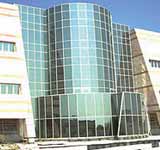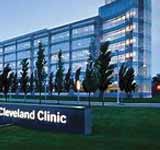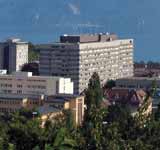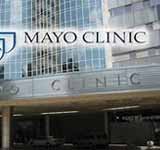1. Massachusetts General Hospital - Massachusetts, United States

The General Hospital of Massachusetts is a teaching hospital of Harvard Medical School and medical research center in Boston, Massachusetts, United States. Mass General serves thousands of international patients each year at its Boston hospital. Since 1811, Massachusetts General Hospital has been committed to providing cutting-edge medical care. Over time, we have made progress in the care we provide because we seek to be pioneers in research and offer education to future medical professionals. We are consistently ranked among the best hospitals in the United States by the US News and World Report. Massachusetts General Hospital or "Mass General" as we are known offers sophisticated diagnostic and therapeutic care in virtually any specialty and subspecialty of medicine and surgery. Our five multidisciplinary care centers bring together specialists from across the hospital to offer patients cutting-edge comprehensive care, making these centers recognized worldwide for their innovations in cancer, neurosurgery, digestive disorders, heart disease, transplants and vascular medicine. Through Mass General Hospital for Children, we also provide a full range of pediatric medical services. It is the third oldest hospital in the United States, and the largest and oldest in New England.
2. Sheba Medical Center - Tel HaShomer, Ramat Gan, Israel

Sheba Medical Center - a public hospital of Israel, located in the vicinity of Tel Hashomer and provides medical care of residents of Ramat Gan and the center of the country. It is also the medical base of the Israel Defense Forces. Shiba Medical Center consists of three medical institutions managed independently from each other: a general clinical hospital, Safra Children's Hospital and a rehabilitation clinic, including geriatrics and psychiatry departments. Shiba Hospital is located on the territory of 600 dunums, which housed 150 different departments and medical clinics. The hospital is designed for 1700 patients. The hospital employs 6,000 specialists, including 850 doctors. Soldiers and officers of the IDF injured and injured are sent to the rehabilitation clinic. This tradition dates back to the founding of the Shiba Hospital during the Arab-Israeli War of 1947-1949 (known in Israel as the War of Independence). On the campus of the Shiba Hospital, there are several departments of the Israeli Ministry of Health, including the Department for the Care of Patients with Disabilities. In addition, there is a committee of workers at Israeli public hospitals, as well as a volunteer center.
3. Assistance Publique: Hôpitaux de Paris - Paris, France

The Assistance Publique - Hôpitaux de Paris (AP-HP) is the public health establishment French exercising the role of regional hospital in Paris and the Ile-de-France. It employs more than 100,000 people, including medical personnel, public service employees, and paramedical, medico-administrative and medico-technical personnel from the public hospital service (FPH). The headquarters of the AP-HP is situated 3 Victoria Avenue in the 4 district of Paris. The AP-HP is heir to the Directorate General of Public Assistance, formerly responsible for the management and administration of hospitals in Ile-de-France. Succeeding the General Council of the hospices of Paris, the General Administration of Public Assistance was created by the law of January 10, 1849. Its status has approached that of other public hospitals with the gradual integration of other establishments. Three decrees of July 22, 1961equate PA with public hospitals, but with significant differences. In 1991, the General Administration of Public Assistance in Paris was renamed: Public Assistance - Hospitals of Paris. This major change shows the importance of its care functions, without renouncing its welcoming mission within Paris and Ile-de-France.
4. Cleveland Clinic - Ohio, United States

Cleveland Clinic - The largest private medical center, which is located in the US city of Cleveland (State of Ohio). The hospital was founded in 1921 by four doctors. Its development was greatly inhibited by the fire that happened 8 years later, which claimed the lives of 125 people, including one of the founders. After World War II, the clinic began to specialize in the treatment of cardiovascular diseases and became a recognized leader in this field. According to reports US News & World the Report, Cleveland Clinic for 15 years in a row remains in the US medical establishment number 1 in the field of Cardiology and is ahead on this indicator even the famous Mayo Clinic. In 2005, the medical center received 2.8 million patients, of which 70 thousand were hospitalized. The clinic employs 36 thousand people (the third largest employer of the state), among which 1700 professional doctors representing 120 different specialties. There are 10 branches in the state of Ohio, a family health center in Florida, units in Toronto and Las Vegas. In 2013, at the request of the Arab sheikhs, a subsidiary hospital in Abu Dhabi was opened. The annual revenue of the medical center exceeds $6.2 billion in 2008 and $258 million was spent on research programs.
5. Johns Hopkins Hospital - Maryland, United States

Johns Hopkins Hospital is a university clinic and the Center for Biomedical Research, Faculty of Medicine, Johns Hopkins University located in Baltimore, Maryland (USA). The hospital was based on money received under the will of philanthropist Johns Hopkins (at that time it was the largest charitable legacy in the history of the United States - $7,000,000 - 137,300,000 US$ in 2013). According to Hopkins, the institution was supposed to combine the treatment of patients with teaching medical medicine to students and conducting research. The hospital's first plans were developed by surgeon John Shaw Billings. The architectural design was completed by John Rudolph Nirnzee and completed by Edward Clark Cabot of the Boston firm Cabot and Chandler. The opening took place on May 7, 1889. The first medical staff was four doctors, known as the Big Four, pathologist William Henry Welch, surgeon William Stuart Halstead, therapist William Osler, and gynecologist Howard Atwood Kelly. Johns Hopkins Hospital is one of the largest, most modern medical centers in the world. According to the US News and World Report, it has been ranked first among the best hospitals in the United States for 20 consecutive years.
6. Lausanne University Hospital - Lausanne, Vaud, Switzerland

The Vaud University Hospital Center, also known as the Lausanne University Hospital (French: Center hospitalier universitaire vaudois), is a health center in Lausanne, in the Canton of Vaud. It is one of the five university hospitals in this European country called Switzerland. The 'University Hospital of Lausanne' in Lausanne, is linked to the Faculty of Biology and Medicine of the University of Lausanne (UNIL), and has around 1,430 beds. The aforementioned is one of the five university hospitals that exist in Switzerland. CHUV's medical services benefit more than 45,000 patients a year. Almost 3,000 babies are born each year in the obstetrics department, and approximately 9,000 employees work at CHUV. This hospital center acts as a general university hospital for people living in the Lausanne area, covering all areas of medical treatment. It also serves as a hospital offering acute and specialized care for the entire Canton of Vaud and parts of so-called Francophone Switzerland. In 2019, this university hospital was rated the leading hospital in Switzerland and the ninth best hospital in the world by Newsweek magazine. As already mentioned, this university hospital is located in Lausanne, near the center of this city, and can comfortably be visited by arriving at the "CHUV" station, on line 2 of the Lausanne Metro.
7. Mayo Clinic - Minnesota, USA

Mayo Clinic - a non-profit organization, one of the largest private medical and research centers in the world. The main employer and city-forming enterprise American city of Rochester (Minnesota). Clinic buildings occupy a significant part of the city center. Dr. William Warral Mayo (1819–1911) was sent to Rochester for distribution in 1863, in connection with the events of the Civil War. He decided to stay in this town for good and a year later moved his family to Rochester. After a quarter century of medical practice, donations from the Convent of St. Francis, Grateful to him for helping to eliminate the consequences of the devastating hurricane, he opened a clinic in 1889. Until 1939, the clinic was headed by his two sons - William James and Charles Horace. The institution was transformed into a medical center of national scale by their partner Henry Stanley Plummer (1874-1936), who introduced innovative diagnostic approaches and developed an original patient accounting system. His name is the oldest campus building, built in 1927 in the Art Deco style. At that time, this building was the highest in the state. In 1969, entered in the National Register of Historic Places of the United States. As of 2012, the Mayo Clinic is an exemplary medical center, which employs 50.9 thousand people, including 3,800 doctors and scientists. The clinic's revenue for 2012 exceeded $8.8 billion, about $500 million is allocated for research. The annual revenue of the clinic in 2013 according to Forbes was $3.74 billion. There is a prestigious medical school at the hospital. Mayo Clinic-sponsored facilities operate in 70 US cities, with the largest units in Phoenix and Jacksonville.
8. Memorial Sloan Kettering Cancer Center - New York, United States

The Memorial Sloan Kettering Cancer Center (MSK) is an institute dedicated to the treatment and research of the cancer. It was founded in 1884 as the New York Cancer Hospital. Its main center is in Manhattan, at 1275 York Avenue, between 67th and 68th Street. In 2017, MSK reoccupied the second place he got in 2015-2016 in the ranking of US News & World Report for centers specializing in the treatment of cancer in the United States. Since 2012, its medical director (physician-in-chief) is the Spanish Josep Baselga, scientific director of the Institut d'Oncologia de Vall d'Hebron (VHIO) in Barcelona.
9. Singapore General Hospital - Bukit Merah, Singapore

Singapore General Hospital (SGH) is the largest and oldest hospital in Singapore, where the foundation of the first building was laid in 1821. The Singapore Health Services hospital occupies a stretch of land in Outram Park, sharing space with four medical specialist centers, namely the Singapore National Eye Center (SNEC), the National Heart Center (NHC), the National Cancer Center (NCC) and the National Dental Center (NDC).
10. St. Luke's International Hospital - Tokyo, Japan

The St. Luke's International Hospital is a general hospital located in the district of Tsukiji Chuo in Tokyo, Japan. It was founded in 1902 by Rudolph Bolling Teusler, a missionary physician sent by the American Episcopal Church. The San Lucas International Hospital is a facility for the training of resident graduate doctors and nurses, as well as for the training of other medical professionals. The hospital has 539 beds and sees 2,550 outpatients on an average day. Established in 1901 (Meiji 34), had a lot of money for the construction of the old ward before the war, and had relations with the imperial family. Hinohara Shigeaki, known for his media appearances and book publishing, has been appointed as honorary director, and a medical social worker has been set up and a medical social worker is stationed.
11. Toronto General Hospital - Ontario, Canada

The Toronto General Hospital is Toronto's largest hospital and part of the University Health Network, a network of three hospitals in the city. It is also the teaching hospital of the Medical Faculty of the University of Toronto. The hospital, founded in 1812, is located in the Discovery District south of Queen's Park. The history of the Toronto General Hospital begins in 1812 as a small military hospital that was used in the British American War. After the war it was established as a permanent facility and was then known as the York General Hospital. Since 1829 it was on the corner of Simcoe Street and King Street. It moved to its present location in 1913 and underwent multiple enlargements and conversions in the coming decades. The part of the building from 1913 is now called College Wing. Since 2002, this part has been home to the so-called MaRS Discovery District, a non-profit organization that has set itself the goal of medical research based on public-private partnership to operate. The house offers a total of 471 beds and specializes in cardiology and transplants, making it a leader in the province of Ontario. In 1986, a surgeon successfully performed a bilateral lung transplant for the first time worldwide. The emergency department treated 28,000 emergencies each year.
12. Charité - Berlin, Germany

Charite (French Charité - lit. "Love for one's neighbor, mercy") is a clinical complex located in four districts of Berlin, the largest hospital in Europe. It is a university clinic for the Humboldt University of Berlin and the Free University of Berlin. Charite was founded in 1710 by King Friedrich Wilhelm and since 1727 it has a modern name. The clinic belongs to the oldest traditional medical institutions in Germany. At the same time, it is one of the oldest university clinics in Europe. Charite consists of more than 100 clinics and institutes, united in 17 Charite centers. The total number of Charite employees is 10,400, a turnover of about one billion euros per year. The clinic accepts 128,000 patients a year in its hospitals and almost 1,000,000 outpatients. It treats patients with a variety of diseases, research, training doctors and scientists at the international level. More than half of the German Nobel fellows in medicine and psychology conduct their work in Charit. Since January 2014, the latest generation of da Vinci system surgeon has been used in Charite Clinic. The robot is designed for minimally invasive surgery of the chest, abdomen and pelvis.
13. St. Jude Children's Research Hospital - Tennessee, United States

The St. Jude Children's Research Hospital is a world-famous and leading hospital for malignancies, especially acute leukemia, in children. It was founded in 1962 by a foundation initiated by actor and comedian Danny Thomas in Memphis, Tennessee. At St. Jude's, many pioneering cancer therapy studies have been conducted in children. St. Jude's started in 1962 with an annual budget of $1 million and 125 employees. The first director of St. Jew's was Donald Pinkel. In the first decade, treatment and research efforts focused heavily on acute lymphoblastic leukemia (ALL), the most common malignant disease in childhood. The cure rate for ALL in children was around 5–10% in the early 1960s. The greatest achievement at St. Jude's was the initiation of large multi-center therapy studies in which certain therapeutic elements were systematically tried out and scientifically evaluated. There were considerable difficulties to be overcome. A major problem was CNS recurrences, which ultimately resulted from the introduction of CNS radiation and intrathecalChemotherapy was largely under control. Furthermore, the widespread therapeutic pessimism had to be overcome. Many paediatricians were reluctant to put severe toxic therapies on the sick children because they would only prolong their suffering. There were also no setbacks with various therapies. However, the survival rate of children with ALL in the early 1970s was 50%. St. Jude's also became a model for similar large therapy studies, particularly in Germany, that started in the 1970s.

